Mastering Poinsettia Growth: A Step-by-Step Guide

Green-thumbed enthusiasts and novices alike find joy and challenge in nurturing a poinsettia. Known for their vibrant colors and association with the holiday season, poinsettias are not just festive decoration but also living plants that need conscientious care. They require an understanding of their daily sunlight needs, suitable indoor conditions, and appropriate watering methods. Moreover, being aware of common health issues that could plague these plants is essential. Growing poinsettias also demands specific planting techniques, including the awareness of ideal soil composition, selecting the right type of pot, and knowing how to repot properly. Look forward to a detailed enlightenment on all these aspects in the subsequent information.
Understanding Poinsettia Care Basics
Cultivating Vibrant Poinsettias: Unveiling the Secret Mix
A sea of vivid-red poinsettias during the yuletide season is a sight to behold. Their captivating red bracts against the rich green leaves are nothing short of holiday magic. But nurturing these tropical beauties requires a well-strategized approach. What does it take to let the poinsettias thrive and bloom in all their glory? Let’s peer into these essential factors that ensure a healthy poinsettia plant!
Primary on the list of priorities is ideal lighting conditions. Poinsettias are much like sun-kissed vacationers craving a good deal of bright, indirect light. Make sure to position them near an east, west, or south window ensuring at least six hours of light exposure to keep them vibrant. Remember, they hail from the tropical deciduous forest, thus despise prolonged direct sunlight, which might lead to scorched leaves and bract injuries.
Next enters the unwavering “Goldilocks routine” for watering poinsettias, not too little, not too much, but just right. Poinsettias are not fans of ‘soggy feet’; they despise sitting in water. It’s crucial to check the top one inch of the pot’s soil – if it feels dry, it’s watering time. Use room-temperature water until it flows out from the bottom of the pot. Discard any excess water left in the pot’s saucer to avoid root rot.
Humidity undeniably holds a key role in the life of poinsettias. Maintaining about 50-60% humidity around the plant encourages a healthy bloom. One can recreate this environment by regularly misting the plant or placing a tray of water near it. Be careful not to drench the leaves, as excessive wetness can invite unwanted fungal diseases.
Poinsettias embrace warmth and detest the cold. The ideal temperature for them ranges between 65-75°F in the day and not below 60°F at night. Cold drafts or exposure to freezing temperatures can cause their leaves to droop and eventually drop off. Conversely, a very warm environment above 75°F can result in premature leaf fall.
Feeding the poinsettias is also crucial. Starting from a month after the blooming season, a balanced houseplant fertilizer needs to go in once every two weeks. Dilute the fertilizer to half strength, ensuring it’s supplied during the watering process. Keep in mind that over-fertilizing can harm poinsettias more than undernourishing them.
Mindful pruning plays a significant role in maintaining bushier poinsettias. After the blooming season, around late March or early April, start the pruning process when bracts fade. Prune hard back to 4-6 inches above the soil until you notice fresh growth. Continue to pinch out the tips during summer and early fall to encourage branching.
Last, but not least, poinsettias require a longer night than day phase to stimulate blooming. Starting around October, keep them in complete darkness for about 12-14 hours per day for a period of 6 weeks. This light deprivation technique encourages them to change their leaf color and set buds again before the holiday season.
Whether you’re planning to display a single poinsettia or create an entire seascape of them, knowing these essential tips can help them flourish. Cultivating poinsettias is not just about dotting holiday decor; it’s all about nurturing these living wonders to their maximum potential. So, with this knowledge in hand, let these fiery red beauties bring home the vibrant touch of the holiday spirit! Happy gardening!

Implementing Proper Planting Technique
‘Mastering the Art of Potting a Poinsettia: A Step-by-Step Guide’
The enchanting poinsettia is a classic holiday plant, offering richly colored bracts and a celebratory spirit. After covering all the necessary elements revolving around the poinsettia’s care, it’s time to delve into a significant factor that ensures plant prosperity – correct potting. We’ve got some valuable tips and steps to help plant enthusiasts successfully pot their poinsettia.
Step 1: Choose the Right Pot
The first task is to select a pot that is proportionate to the plant’s size. A pot with drainage holes is essential, preventing waterlogging and associated root issues. The poinsettia enjoys a breathable home, so feel free to opt for clay pots over plastic ones.
Step 2: Prepare a Suitable Potting Mix
Poinsettias prefer a well-draining, porous soil, mimicking their native Mexican environment. A potting mixture containing peat moss, sand, and perlite or a cactus soil mix with compost added will be a perfect blend.
Step 3: Remove Poinsettia from Old Pot
When it’s potting time, tap the sides of the current container and gently lift the plant by its root ball. It’s prudent to exercise care to minimize root damage during this transfer.
Step 4: Positioning in the New Pot
Place adequate potting mix at the base of your new pot and then implant your poinsettia. The top of the root ball should be just below the pot’s rim, allowing ample room for watering.
Step 5: Add Remaining Soil
Ensure to surround the plant roots with the potting mix, patting down gently but not packing it too tightly. Leave about an inch of space between the soil surface and the rim of the pot for watering purposes.
Step 6: Watering After Potting
Always water a recently repotted plant thoroughly. Do so slowly, allowing the moisture to percolate down and reach the lower layers of soil. It ensures the root system gets a good soaking while helping the soil settle.
Step 7: Place in Ideal Spot
After potting, return the poinsettia to its happy place in your garden or home that already meets the pre-discussed lighting and temperature requirements.
Make no mistake, successfully potting a poinsettia brings an unmatched level of satisfaction, particularly as this holiday star begins to thrive under robust care. It’s a process that combines knowledge with passion, paving the way for stunning visual displays straight from the heart of Mexico into the comfort of your own dwelling. Happy Potting! Be ready to amaze everyone with that verdant elegance!

Maintaining Poinsettia Throughout the Year
Transitioning Your Poinsettia to the Outdoors
As the excitement of the holiday season dwindles, it’s time to consider the future of your festive poinsettia. You might be tempted to move it directly outdoors, but this is not advisable. The drastic temperature changes could shock the plant and jeopardize its growth. Instead, start by placing your poinsettia near an open window where it can gradually acclimate to the outside temperature changes, weather conditions, and shorter daylight hours.
Once your poinsettia is accustomed to the climate shifts, you can start bringing it outside for several hours each day. Start with durations of two to three hours and gradually escalate these periods. Ensure the plant is kept in a shaded area to avoid sun scorch. After a few weeks, the poinsettia should be prepared for full-time outdoor living.
Leveraging Natural Light
While the above-mentioned section has detailed the gradual acclimatization of poinsettias to outdoor light after the holiday festivities, it’s also crucial to explain the post-transition light requirements. The poinsettia flourishes under conditions of direct morning light and afternoon shade. A north or east-facing location works great in ensuring these conditions. This balance helps to prevent sunburn or leaf scorch that harsh sunlight may cause.
Continuing Care
Outdoor life doesn’t signify the end of attentive care for your poinsettia. Regularly check the moisture levels of the soil and inspect for any pest infestation. As poinsettias become accustomed to outdoor life, there may be an increased risk of pests like spider mites and whiteflies. Attentive checking and maintenance will help to prevent any lasting damage.
Time to Bring It Back In
Returning your poinsettia inside before the first fall frost is crucial. Remember, the plant acclimatized slowly to outdoor conditions? It’s the same principle when transitioning back indoors. Gradually reduce its time outside every day so it can adapt to the lowered light and temperature conditions of your home. Make sure to check your poinsettia for any pests that might hitch a ride inside – a quick rinse with water can easily prevent a future indoor infestation.
Guidance on Re-flowering
It’s a myth that getting a poinsettia to reflower is a grueling task. Consistent care and adequate preparation are key. Around mid-September, ensure your poinsettia undergoes a strict regimen of 12-14 hours of darkness every day. Use a box or bag to enforce this light deprivation if necessary. This process triggers the bract coloration and paves the way for the new flowering season. After 8-10 weeks of this routine, the plant should be ready for the holiday spotlight once again.
With these added instructions, your cherished poinsettia is sure to continue thriving after the holiday season, lending its festive charm throughout the year. Pat your green-thumbback in satisfaction knowing you have played an instrumental role in maintaining and rejuvenating this holiday icon!

While poinsettias are most popular during Christmas, their beauty can be cherished throughout the year with the right care practices, such as proper trimming, fertilizing, and maintaining the ideal temperature and lighting conditions. Fostering poinsettias beyond the festive season makes our homes vibrant and lively all year round. With an understanding of the poinsettia care basics, implementing the correct planting techniques, and knowing how to maintain them throughout the year, you’re set to have a thriving poinsettia that will be a source of pride and joy in your indoor garden.



